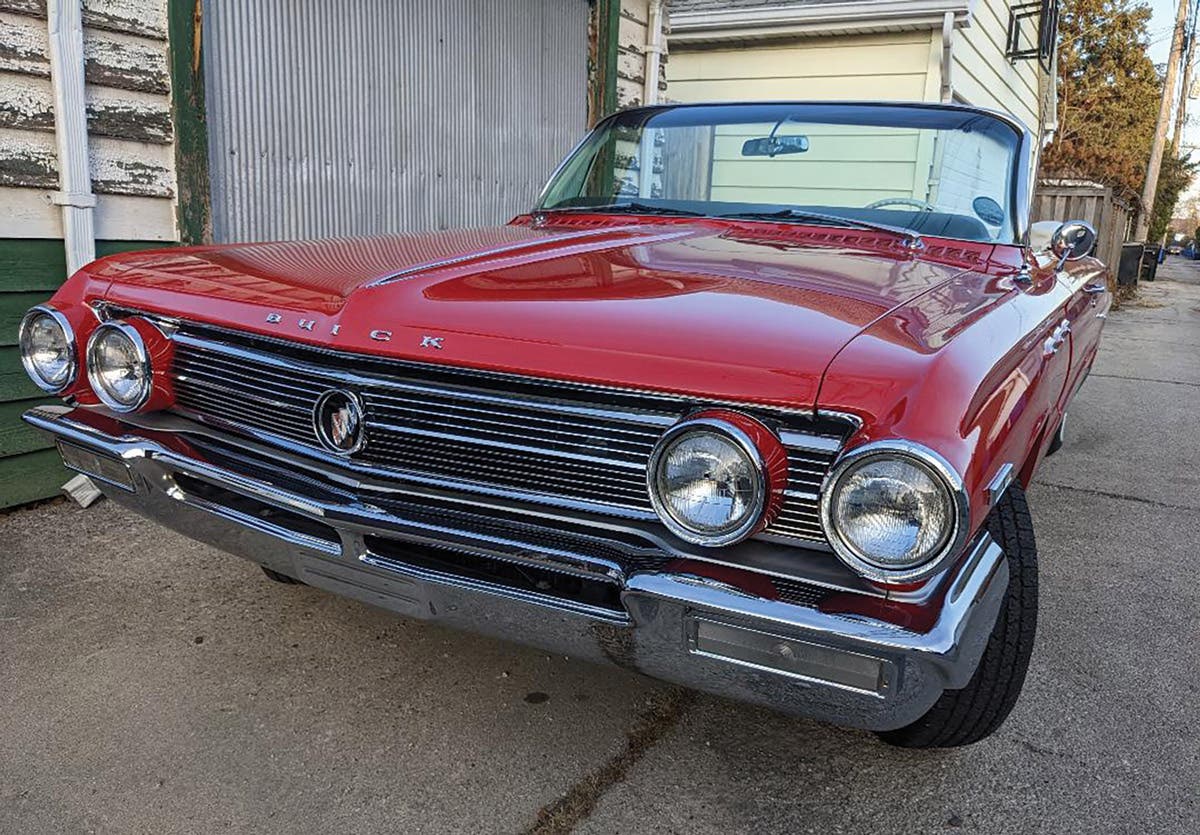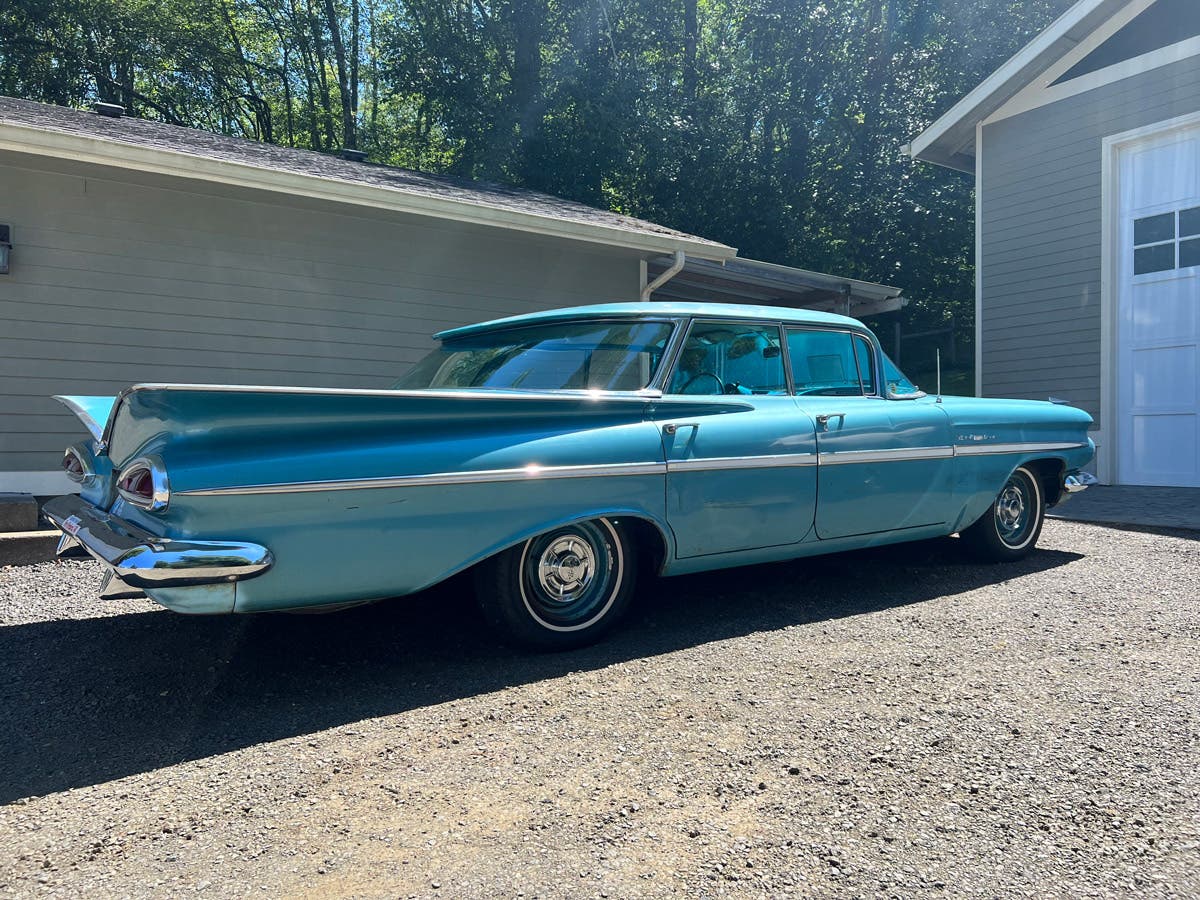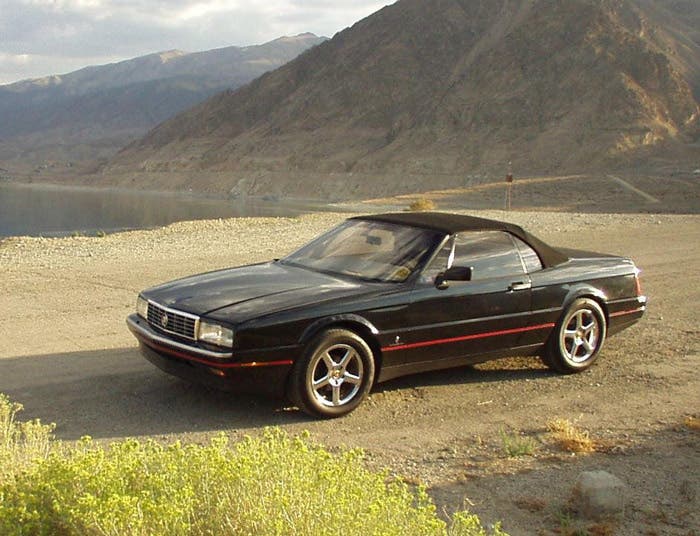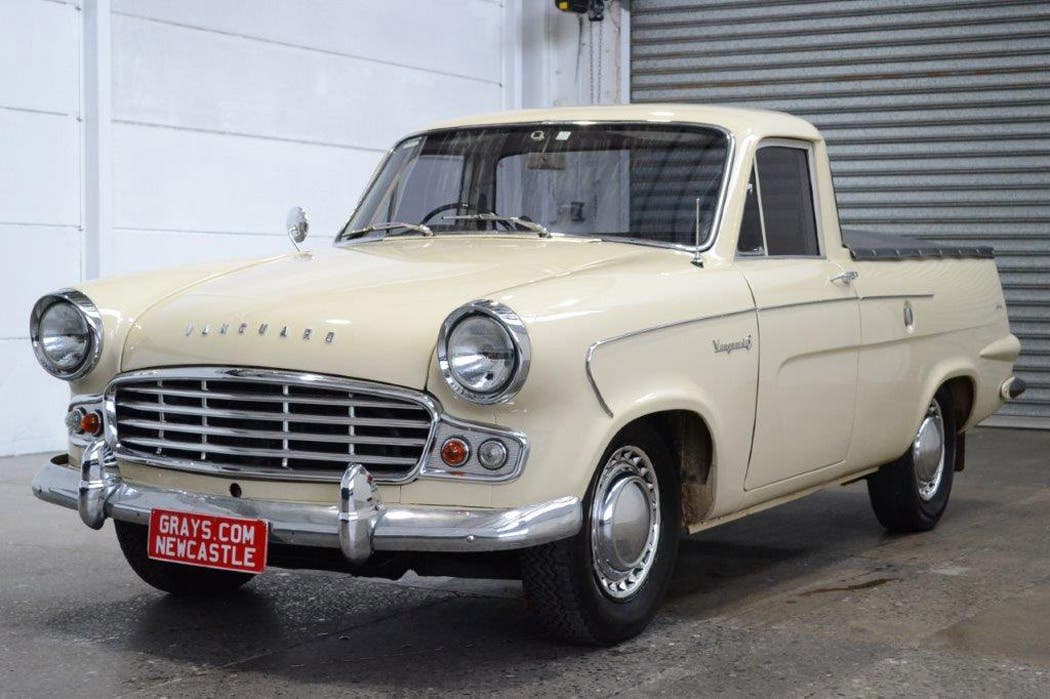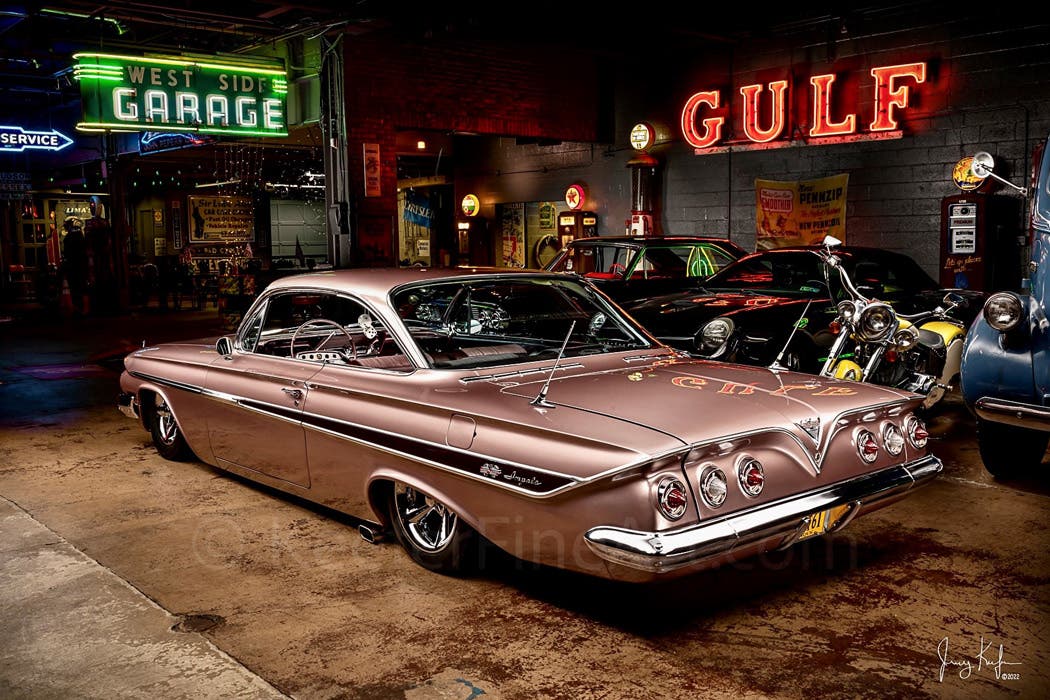Dad’s Desirable Drivers
A man who chose Classics for his daily drivers
The 1939 Packard Super Eight Darrin is pictured here against
the buildings of downtown Miami around 1940.
My late father, David O. Hutchinson III, was known for owning many true Classic automobiles during the ’30s, ’40s and early ’50s. Many of these Classics were among the most unusual and desirable cars ever created. In a time one could purchase a new Fleetwood Cadillac for less than $3,000, my father chose to pay $4,800 for a ’39 Packard Darrin victoria offered by a dealer in Hollywood, Calif. This was an astronomical figure for anyone to expend on an automobile just before World War II, when America was still experiencing the devastation of the Depression.
My father was born Jan. 18, 1914, and from an early age, he was an entrepreneur and self-styled individualist. In 1931, at the age of 17, he had two thriving businesses. After the war, he sold his highly successful scrap-iron salvage business, but retained his St. Petersburg, Fla.-based wholesale nursery company, the World’s Largest Wholesale Palm Dealer.
My father was a visionary extraordinaire. It made little difference to him if an idea involved his personal dress, a custom speedboat, his Spanish-style home and landscape surroundings or a certain type of business truck; he wanted it to be classy and noticed. Nowhere was this revealed more than in his selection of personal automobiles. It is for this reason I recall my father’s exact words stated on numerous occasions: “I never want to see myself coming around the corner.”
My father’s affinity with exotic custom automobiles started with a unique 1932 purchase. In the ’20s and ’30s, European countries held a major portion of the custom-bodied auto market. A team on that continent known for radical body lines and rakish curves was an Italian-born twosome who founded Figoni et Falaschi, a coachworks company near Paris. My father located one of the firm’s early one-off cars built for a French buyer, which was later sent to America. The car was a Figoni et Falaschi-bodied 1931 Isotta Fraschini with drop-head coachwork. (Recently, this extremely unusual open Classic was offered in a Blackhawk auction.) The Isotta was to be the first rare custom he would own; however, many other recognized Classics would follow. All were either new or less than a year old when they were purchased, and all of these special cars were used as daily drivers. In addition to these rare Classics, my father also owned several expensive “production” cars, provided for my mother and grandmother during the years.
Given my father’s taste, I rode in several beautiful examples of rolling art daily while growing up in St. Petersburg, Fla. I recall the comments made to my parents and grandmother by those admiring these cars. Whether in a service station or grocery store, while being dropped off at school, or attending a church function, bystanders noticed the cars my family owned. During school reunions in the years that followed, my former classmates have recalled the cars we had with remarkable detail.
I am not old enough to have experienced all of these unusual cars owned by my father, but those he owned prior to my being old enough to remember were captured in photos or talked about by my father.
This 1940 photograph shows the 1939 Packard Darrin after it
had just been purchased by David Osborne Hutchinson III from a
Hollywood car dealer. It is shown with Hutchinson's 1936 Auburn
Speedster before it burned in a body shop fire.
An Auburn and a Cord
The first of the seven custom automobiles my father owned following the Isotta Fraschini and before the custom Cadillac period was a ’36 Auburn Speedster. Its power came from the supercharged 150-hp, 279.9-cid Lycoming straight-eight. The low-production Speedster sported four massive chrome exhaust pipes exiting from the driver’s side hood panel, giving the sleek Auburn the appearance it was moving 100 mph when it was parked. I retain a picture of this Art Deco Classic, taken prior to the 1940 Miami body shop fire where the two-seat Speedster was destroyed.
The next Classic was a front-wheel-drive ’37 Cord Phaeton with the supercharged V-8. Like the Auburn, this car also had chrome external exhaust pipes exiting from the hood, but in this case, the pipes were located on both side panels. My mother told me this was her car, as it was light yellow with red leather interior and seated four passengers.
Another photo of the 1939 Packard Super Eight Darrin.
The first dance with a Darrin
The first of two Darrin Packards owned by my father was a ’39 Hollywood Super Eight Series Custom Darrin victoria (convertible) and was powered by the venerable 160-hp, 356-cid Packard straight-eight. The early Packard Darrins of 1937-’39 were hand built in Hollywood, Calif., by Howard “Dutch” Darrin’s shop on Sunset Boulevard. New Packard One-Twenty and Super Eight coupes were utilized to create the Hollywood Darrins. I have several pictures of this Classic, as well as the story of its original owner and how it arrived in Florida in 1940.
This photo of the first Packard Darrin was taken with trees as a backdrop in
St. Petersburg, Fla., around 1943. Notice the car's eteneral exhaust pipes and
how daily use was affecting the paint, evident by the lifting paint on the fender skirt.
My father had taken the train from St. Petersburg, Fla., to California to purchase the ’39, which had been sold by the movie star Chester Morris to a Hollywood dealer. The trip back to Florida was a planned race by my father to see if he could arrive in St. Petersburg before the train. He won by several hours, but slept for two days after that challenge. One has to recall that those were the days before highways bypassed towns. It was something only a young 26-year-old would venture, wanting to prove it could be done in a fancy Packard.
This factory photo shows one of the 12 Count Alexis de Sakhonoffsky-designed
1940 Nash Ambassador victorias (six were sold and the remaining six were
converted back to Ambassador convertible coupes). One of these cars was
owned by David Osborne Hutchinson III, but no photos are known to exist
of his car.
Neat Nash victoria
The fourth custom car was an extremely low-production example. It was a ’40 Nash Ambassador convertible hand built by the Russian industrial designer Count Alexis de Sakhnoffsky. Six were built, but only two are known to exist today. I do not have a picture of my father’s car, but I do have copies of the original set of drawings made by the Count, as well as my mother’s recollections.
My mother recalls my father paid $4,500 to an Orlando, Fla., dealer in 1941, and the car had a small plaque on the dash baring the count’s name. I have seen one of the two originals that currently exist, and have spoken to the owner of the other example at his home in Virginia. These six radically customized convertibles were powered by the stock Ambassador straight-eights with dual ignition plugs.
In 1976, my family visited Harrah’s 1,100-automobile collection in Reno. My sons and I spent two days viewing what was then the largest single classic auto collection in the world, and Harrah’s had the custom Nash there on display. The Sakhnoffsky Nash incorporated certain styling modifications also found in the Darrin Packards: the rakish boat-style windshield, the dropped side belt line and the low-cut doors. It did not have roll up windows, but was like the Auburn Speedster that utilized glass and canvas side curtains. Harrah’s example was sold in the early ’80s at the estate auction held after Bill Harrah’s 1978 death. The other restored example is owned by Reggie Nash of Virginia.
The fifth car I know very little about, other than it was a black ’41 Lincoln Continental Cabriolet. 1940 was Lincoln’s first production year for this car’s Continental European styling. The V-12 Zephyr name was retained in 1940, but dropped in 1941. My father drove it during the early days of the war, including on a trip to Maine to get my mother and me when I was about three years old. I can only imagine how he was able to buy gas for such a trip during the gas-rationing period.
The author, David Osborne Hutchinson IV, with his father's second Packard
Darrin, a 1941 One-Eighty victoria, in 1946. The author rode in this car as
a child for close to five years.
A second dance with a Darrin
The sixth and seventh cars overlapped, as my grandmother and my father owned them during the same period. By 1940, Packard had noticed the successful market “Dutch” Darrin had created with the Hollywood elite for his custom-bodied Packards. The company made arrangements for the 1940 Darrins to be constructed more to their standards, and construction of these cars moved from Dutch’s California operation to the old Auburn factory in Connersville, Ind. The 1941 and the last of the 1942 Darrins were built by Dutch, but in a different location. My father’s sixth custom, and second Packard Darrin, was a ’41 One-Eighty victoria. It was powered by the same 160-hp 356-cid straight-eight engine as the Super Eight of 1939.
This car was off-white with a black convertible top. I have several pictures taken from 1943-1950, as these were the years I rode daily in this spectacular automobile. Some time in late ’46 or early ’47, my father changed the color to a black body with a white convertible top and a complete black-and-white pigskin interior.
Eventually, the colors of the 1941 Packard Darrin were reversed
from a white body and black top to a black body and a white top.
The author is shown here with his grandmother, Mrs. A.T. Hutchinson,
who used the car every day. This circa-1950 photograph was taken just
before the car was driven to Miami to be sold. The author notes:
"Grandmother was hard on whitewall tires. Remember, the Darrin did
not have power steering... I often helped with the wheel when parking."
At this point, my father had turned the black ’41 Darrin over to my grandmother and sold her 1942 Oldsmobile Ninety-Eight. My grandmother was never pleased with driving the Darrin, as her Olds had been Hydra-Matic-equipped, and she found it extremely difficult to see over the long Packard hood. I recall helping her see around the hood by leaning out my window for a clear view when climbing hills or driveways. “Dutch” Darrin’s Packards were given extended hoods by fabricating cowls that placed the rakish windshield further back into the driver’s cockpit. This, along with the lower bucket seats and cut-down doors, made driving a challenge for my grandmother. The Darrin was sold in Miami in 1950 to a Chicago collector.
There is an interesting story about what happened to the ’41 Darrin after it was sold. In 1989, I attended a regional Antique Automobile Club of America event in St. Petersburg, where many finely restored classic automobiles were being shown. While speaking to the late Tom Mix, the owner of another beautiful ’41 One-Eighty Darrin victoria (he was a distant relative of the famous cowboy Tom Mix killed while driving his ’37 Cord), there was a burgundy ’41 production Packard One-Sixty convertible parked next to him. In the course of relating the story of my father’s ’39 Darrin and his black ’41 Darrin, and how the ’41 had been sold in 1950, the owner of the production One-Sixty shared an experience. In 1962, he had been in Chicago to view several Packards for sale by a collector, and among the selection was an original black ’41 Darrin with a black-and-white pigskin interior. There was no doubt this was my father’s ’41 Darrin. He said he could not afford to purchase the Darrin, but did purchase the One-Sixty convertible. He could not tell me where the Darrin went, however, I would like to meet the current owner or speak to anyone who may know of its whereabouts.
A customized Continental
The seventh classic was a ’46 Lincoln Continental V-12 Cabriolet, which was purchased in late 1946 or early ’47. I do not retain any pictures of the Continental.
My father’s Lincoln Continental underwent a radical customizing in either late ’47 or early ’48. He delivered it to a body shop in Pennsylvania capable of performing the extensive modifications he had designed. The white convertible top, windshield and door windows were chopped or lowered 3 inches. The chopped convertible top, from the back of the front seat to the rear deck or trunk area, was made permanent and non-functioning. Over the front seat area was a matching removable snap-away canvas chauffeur top. At each rear quarter area of the top, my father placed custom oval-shaped portholes, and just to the rear of these were chrome landau bars from a 1926 Buick. The bars were about 16 inches long, and with the oval portholes placed at a slightly forward angle, this car was an astonishing beauty. To top it off, the Continental was painted chartreuse green. The Continental made a trip to California in 1948, when my parents drove it 8,000 miles.
During this era, the Ford Motor Co. placed the smaller Zephyr V-12 engines in these Lincoln Continentals. The underpowered V-12 did not measure up to the venerable Packard and Cadillac eight-cylinder engines. Prior to a 1948 trip to California, the V-12 in my father’s Continental had been rebuilt, but he still found the car did not have sufficient power to pull certain Rocky Mountain passes in low gear, adding to overheating and vapor-locking problems that plagued him on the entire trip. In those years, it was very common to see cars carrying extra water in canvas water bags on their bumpers. The pictures from my father’s trip are still in my mind’s eye, where the Continental had a water bag hanging from the front bumper guard.
After this Lincoln, my father began purchasing Cadillacs, starting him on a new path of expressing his individuality.
If you enjoy great reader stories like this,
consider a subscription to Old Cars Weekly.
52 issues a year!Subscribe >>
More Resources For Car Collectors:
- Classic car price guides, research, books, back issues of Old Cars Weekly & more
- Get expert restoration advice for your classic car
- Get car pricing, data and history all in one place
- Sign up for Old Cars Weekly's FREE email newsletter
- Need to buy or sell your classic car? Looking for parts or memorabilia? Search our huge online classified marketplace



